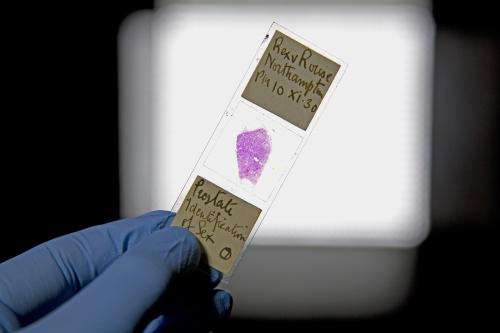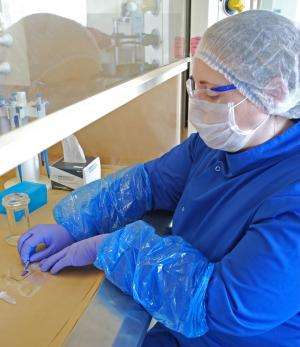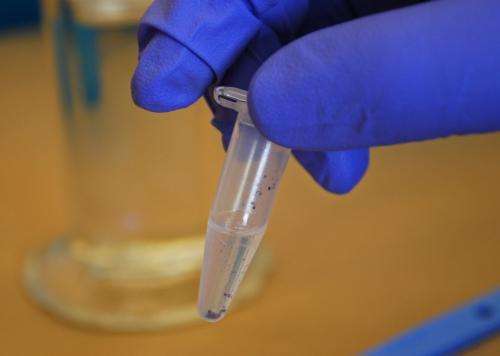Academics provide answers on famous murder case

University of Leicester leads collaboration with Northumbria University, Northamptonshire Police and The Royal London Hospital Museum, in investigation of the Blazing Car Murder of 1930
A forensic team from the University of Leicester and Northumbria University has spearheaded an investigation which has shed new light on a murder case from 1930.
A team from the University of Leicester, led by Dr John Bond OBE from the Department of Chemistry and Dr Lisa Smith from the Department of Criminology worked with colleagues from Northumbria University, Northamptonshire Police and The Royal London Hospital Museum to tackle the riddle of the 'Blazing Car Murder' from over 80 years ago.
The case involved the murder of a male in a car fire in Hardingstone, Northamptonshire, on 6 November 1930. Alfred Rouse was convicted, and later hanged, at Bedford Gaol in March 1931, for murdering his victim who to this day, has not been identified.
At the time, a post mortem examination was carried out in the garage of the local public house by the Home Office-appointed pathologist Sir Bernard Spilsbury, working alongside another local pathologist.
Sir Spilsbury reported that lavender coloured material and light brown hair were found at the scene. It was further documented that the victim's jawbone was removed to assist with possible identification and tissue samples taken for microscopical examination.
Two of these tissue samples are still in existence and archived in The Royal London Hospital Museum: one from the prostate to confirm the sex of the victim, and another from the lung to determine whether or not the victim was already dead before the fire was started.
In recent months, attention has turned to the fact that a man named William Briggs left his family home in London to attend a doctor's appointment at around the same time the crime was committed - and was never seen or heard of again.
As part of their family ancestry research, the relatives of William Briggs wanted to verify earlier generations' belief that their ancestor may have been Rouse's car murder victim.
Last year, a number of William Briggs's relatives approached Northamptonshire Police in an attempt to put the 83-year-old mystery to rest and finally reveal the identity of the victim.

They met with the Force's curator and archivist Richard Cowley, discussed the story of the murder and were shown artefacts relating to the crime which, at the time received worldwide attention.
With the help of Northamptonshire Police, the family contacted University of Leicester academic Dr John Bond OBE. He and Dr Lisa Smith negotiated with The Royal London Hospital museum to allow one of the remaining tissue samples to be examined.
The slide was released with the approval of Professor Richard Trembath, at Queen Mary College University of London. The slide originates from the old Department of Forensic Medicine which formed part of The London Hospital Medical College. The College was merged with Queen Mary College in 1995.
The University of Leicester team considered whether there might just be enough mitochondrial DNA (mtDNA) left on the slide to get a profile to compare with mtDNA from the family.
Mitochondrial DNA is wholly inherited from the maternal line so it is essential to have an unbroken maternal line of descendants to test.
University of Leicester worked with the Northumbria University Centre for Forensic Science and Dr Eleanor Graham, a former member of staff at the University of Leicester, and Victoria Barlow to carry out DNA analysis on the samples to see if there was a match from the sample and the relatives.
Fortunately, the scientists obtained a full single male mtDNA profile from the slide to compare to the family.
Dr Lisa Smith, from the University of Leicester said: "It's been very interesting and rewarding working on such a famous, local murder case. It was quite a unique investigation to be involved in, as the perpetrator had been identified long ago and brought to justice while the victim's identity remained unknown.
"It was a great example of how the scientific and criminological expertise at the University of Leicester and Northumbria University, working together with the police, could provide answers to this family after 83 years."

Detective Chief Superintendent Paul Phillips from Northamptonshire Police said: "From our perspective this is a closed case, the offender Alfred Rouse was convicted of murder and hanged, but this has been a long-standing mystery in Northamptonshire as the identity of the victim has never been established.
"Our work at Northamptonshire Police is victim focused so I was delighted to learn of new opportunities to establish the identity of the victim through the development of forensic science."
Dr Eleanor Graham from Northumbria University stated: "Projects such as this highlight the fact that forensic DNA analysis is not confined to 'catching criminals'. DNA analysis also has a critical role to play in the identification of those who have been killed during criminal acts, accidents or natural disasters, which have occurred recently, or many years ago."
The result is due to be revealed to the family on the BBC's The One Show on a date to be fixed.
Provided by University of Leicester

















